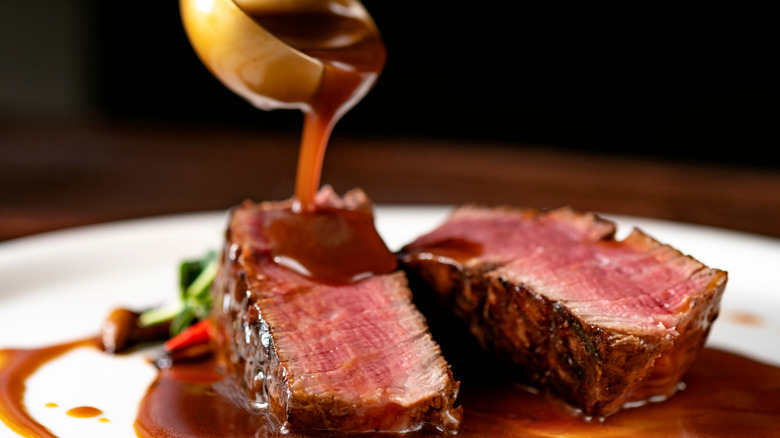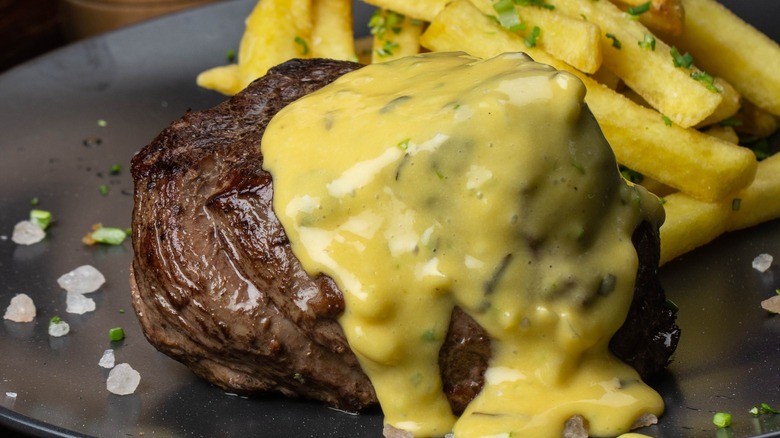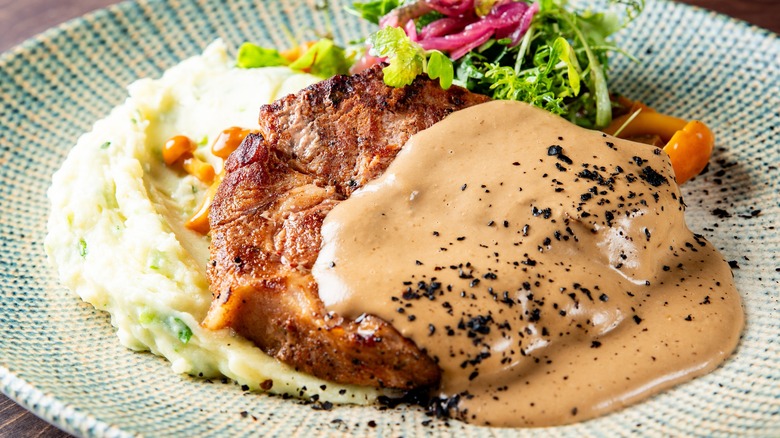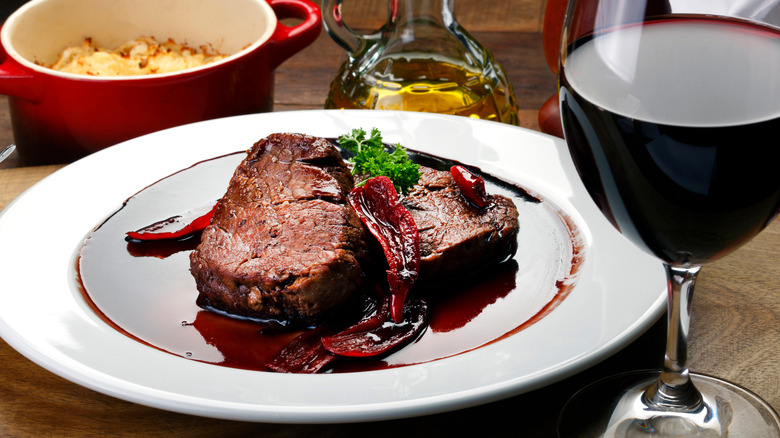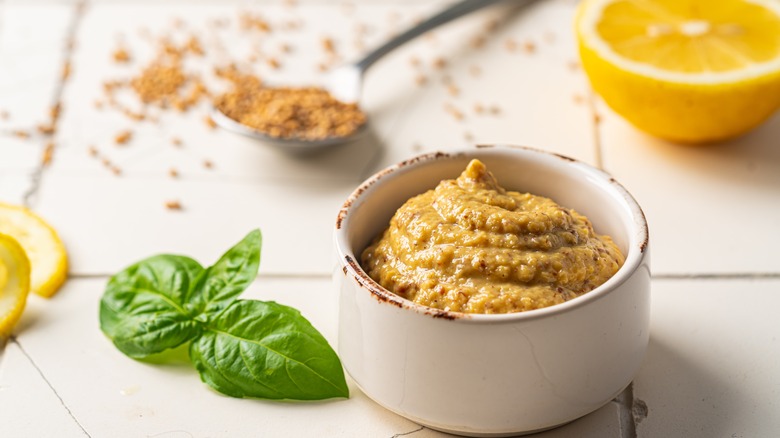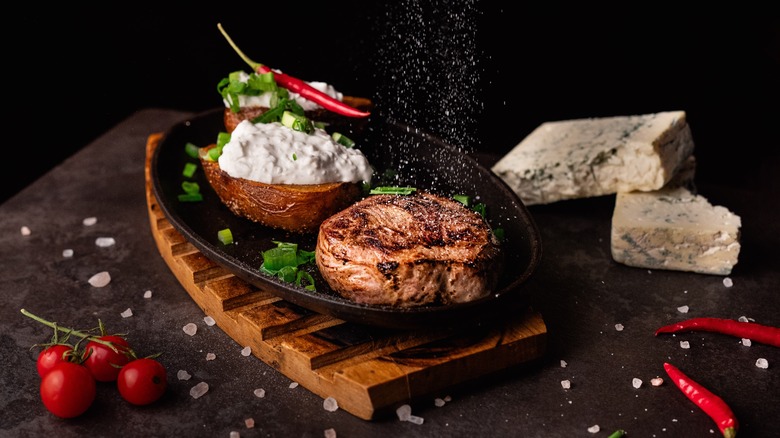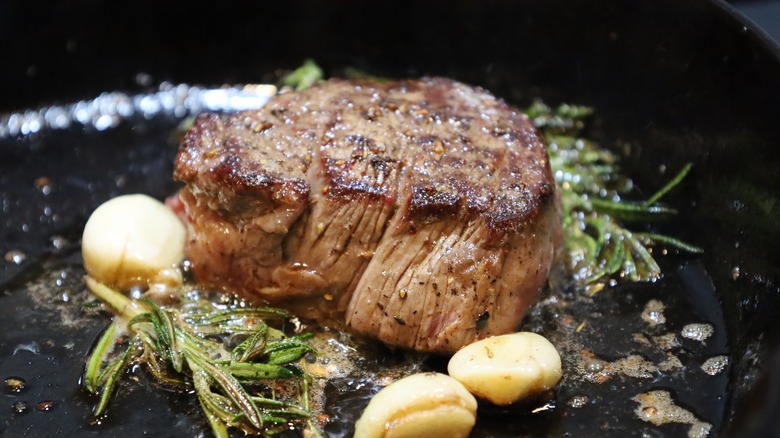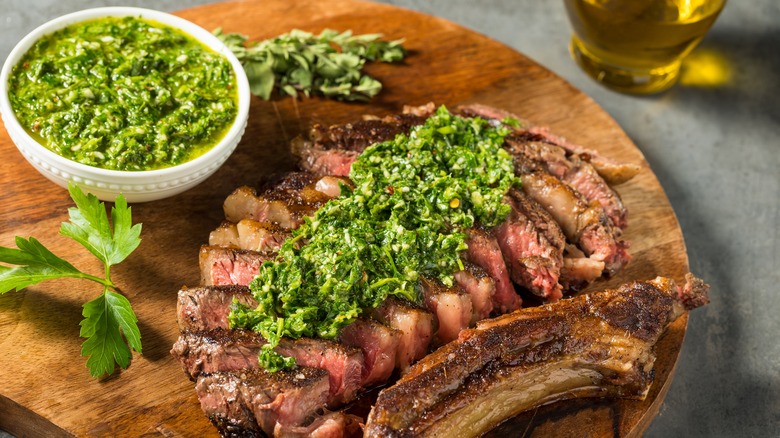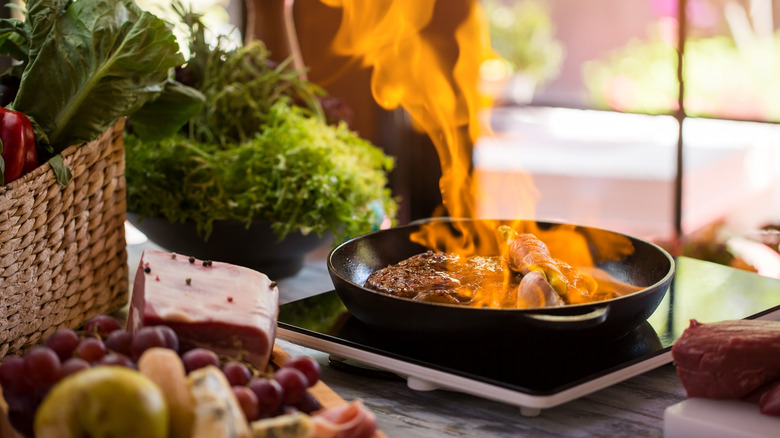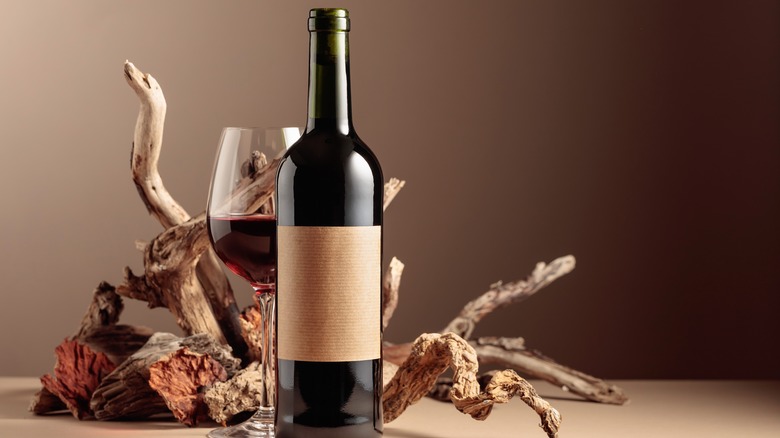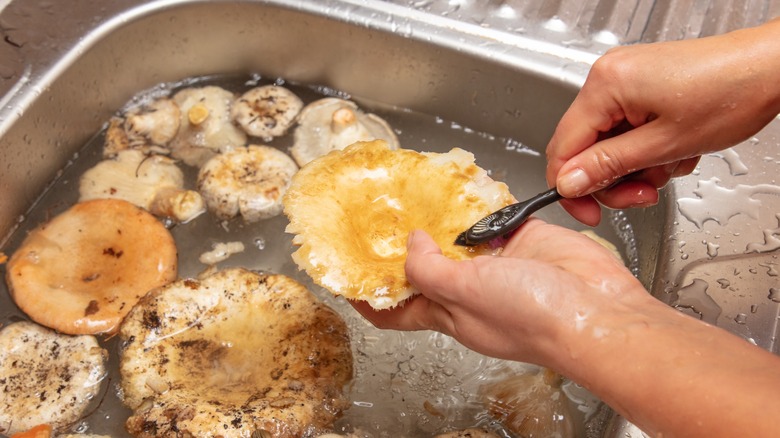Mistakes Everyone Makes With Homemade Steak Sauce
If you are a meat lover, then a steak dinner is likely one of life's delicious luxuries — a juicy steak, seasoned perfectly and served with fries is a dinner that can hardly be bettered. To elevate your steak even further, a perfectly cooked sauce can make the difference between a satisfying steak experience and a memorable one. From a creamy Béarnaise to a zingy chimichurri, there is a steak sauce to suit you no matter what mood you are in.
However, sauces can be tricky for a home cook, and there are a number of common pitfalls that can scupper your steak sauce. From the bottle of wine you choose to the temperature of your ingredients, simple decisions can make or break your chances of success.
By fixing these potential errors, you can prepare your steak with confidence and impress family and friends when you serve them your restaurant-quality steak dinner. Join us as we take a look at the most common mistakes you may be making with your homemade steak sauce, and how to avoid them.
Using cold ingredients in your béarnaise
Béarnaise sauce is a classic sauce commonly served with steak, but home cooks are often hesitant to try making it themselves, as it can be temperamental. It is based on Hollandaise sauce, which is one of the Mother sauces of French cooking, and requires you to emulsify egg yolks, something that can be tricky if you're new to the technique. If you have tried to make Béarnaise before and the sauce has split, it may be down to the temperature of your ingredients.
The eggs and butter should be at room temperature before you attempt to make your sauce, as cold ingredients can prevent them from mixing properly and result in a split sauce. By taking your eggs and butter out of the fridge well in advance, you will increase the chance of a successful Béarnaise sauce. If you have no option but to use chilled ingredients, cooking it slowly over a bain-marie will help to prevent the sauce from splitting.
Another way to reduce the chances of your Béarnaise sauce splitting it to use clarified butter instead of the regular stuff. Clarified butter, which is liquid at room temperature and doesn't need to be refrigerated, is 100% fat, compared to around 80% fat in butter, and the lack of water makes the emulsification process easier. These little details with your ingredients can mean the difference between a beautiful, silky Béarnaise sauce, and having to throw it in the bin and serve your steak with ketchup — again!
Not using freshly ground peppercorns
A creamy peppercorn sauce is one of the true classic steak sauces, made with just a few ingredients — it's a great option to cook at home. With such a simple recipe, though, it is crucial to get every ingredient right, because if anything is sub-standard, it will show. Using the right form of peppercorns is probably the most crucial part of the recipe, and one that many home cooks may be getting wrong without realizing.
Most of the flavor in this sauce comes from the peppercorns themselves, cutting through the decadent heavy cream. But there is more to the peppercorns than simply their robust flavor. The spiciness from pepper actually increases your ability to taste other foods, meaning the deliciousness of your sauce will be increased by the addition of the black pepper. This effect is at its strongest when the inside of the peppercorn is first unleashed, meaning that pre-ground pepper will have very little impact.
Although pre-ground black pepper is convenient, taking a few seconds to grind it at the time will seriously elevate this sauce, as well as the rest of your food. So take this as an excuse to go out an buy a pepper mill, fill it will whole peppercorns, and keep it on your countertop, ready to grace your cooking with a burst of spicy aroma whenever you need it.
Not reducing your red wine sauce enough
Ordering a red wine sauce with your steak in a restaurant is a delight, watching it cling to the meat as you pour it on top, then forming a thick pool on your plate (perfect for dipping your fries into.) If you have ever tried to recreate this in your own kitchen, you may have ended up with a disappointingly thin liquid that runs all over your plate, threatening to flush away any flavor it comes across. A watery sauce is caused by not reducing your red wine sauce properly, meaning you don't get the mouthwatering concentrated flavor you would expect.
The purpose of reducing your wine sauce is to evaporate a large proportion of the water, leaving behind the intense flavor in a thicker sauce. The key to this process is patience — if a watched pot never boils, then you are going to feel like your sauce has been reducing for hours as you stare at it bubbling away. The aim is to reduce the liquid content by at least half and increase the viscosity from runny liquid to shimmering glaze. If you think it is nearly ready, dip a spoon into the sauce. If it clings to the back of the spoon, your sauce is spot-on, if not, keep waiting for it to thicken further. While this may seem like a long drawn-out process, it will totally be worth it when you pour that beautiful glaze over your steak at the end.
Overpowering the steak with mustard sauce
Mustard and steak are a great match, the heat of the sauce cutting through the rich meat and leaving a tangy (sometimes fiery) tingle on your tongue. If you're short on time, a dollop of mustard straight from the jar can work, but a homemade mustard sauce will be a much better pairing to your juicy steak. But it can be easy to use too much mustard in your sauce, and that doesn't bode well for enjoying the taste of your steak. Balancing the flavor of the mustard by choosing the best variety is key to creating a sauce that complements the steak, rather than assaulting your taste buds.
There are many different mustard varieties, but the most common ones used here are English, Dijon, wholegrain, and American.
English mustard is the hottest of this bunch and, unlike the other varieties, it doesn't have vinegar to dilute the heat. It packs a mighty punch, and unless you are a huge fan of it, the flavor is probably too much to give subtle heat to your steak dinner. American mustard sits at the opposite end of the scale, made from yellow mustard seeds which are the mildest. If you are using mustard straight-up, American will work well, but it's a bit too subtle for the perfect steak sauce.
Dijon and wholegrain are the best options for your mustard sauce — Dijon if you want it strong, and wholegrain for a slightly sweeter touch. Both mustards will give you a well balanced sauce that will give your steak an exciting edge without completely ruining the flavor of the meat.
Not melting your blue cheese properly
If you are a fan of a strong blue as part of your cheese board, you will definitely love adding a blue cheese sauce to your steak. The strong umami flavor from the cheese, coupled with the rich cream, matches the meatiness of the steak perfectly, creating a delicious savory combination.
Melting the blue cheese completely is the key to a beautiful, silky sauce. Nobody wants a lumpy sauce alongside their juicy steak, so taking the time to melt the cheese properly is crucial. Depending on the type of cheese you are using, it may be reluctant to fully melt — but have patience, it will get there. Gorgonzola dolce will melt nicely while still giving you the salty kick, but a strong Stilton may take a bit more coaxing. If your cheese is being extremely stubborn in its quest to remain solid, try gently whisking as it simmers to remove the last of the lumps.
Don't turn the heat up too high in an attempt to help the cheese melt, as it could cause the cream sauce to split or burn. Persistence at a medium heat and with constant stirring is the key to a luxurious and silky sauce. A generous sprinkle of fresh herbs such as parsley will lift the flavor of the sauce, but avoid adding salt until you have tasted the finished dish, as it is likely to be salty enough.
Burning the garlic in your butter
Sometimes the simplest sauces are the best, and making a sauce with garlic, butter, and a few herbs is as deliciously simple as it gets. A simple sauce, however, means it's harder to cover up any mistakes, especially if you burn the garlic.
Burnt garlic has an acrid, bitter taste that will spoil the sauce and ruin your juicy steak dinner. The unpleasant taste is due to the compound allicin – which is responsible for the familiar garlic flavor – breaking down too quickly. Garlic can turn from beautifully golden to black and crispy within seconds, so it is crucial to take steps to stop this happening as you make your garlic butter sauce.
Like all foods, garlic cooks more quickly when cut up into smaller pieces. While this is helpful if you're, say, cutting butternut squash into small cubes to reduce the cooking time, it can work against you when it comes to frying garlic. The smaller your slices of garlic, the faster it will burn. So, instead of dicing the garlic, you can slice it into thin strips and add it to a cold pan with oil, then heat it gently to prevent scorching.
Once the garlic is a pale brown color, add the butter and fresh herbs, then cook for a few more minutes on a low heat. The oil will prevent the butter from burning too, leaving you with a beautifully fragrant sauce to pour over your steak.
Adding too much acid to your chimichurri
If you're not in the mood for a rich, creamy sauce with your steak, then a vibrant chimichurri can be a refreshing change instead. The acid in the sauce offers the perfect contrast to the beef, but getting the balance right is crucial, to prevent your sauce becoming too sour and overpowering the steak.
Chimichurri sauce originated in Argentina and Uruguay and consists of fresh herbs — usually parsley and oregano, though others can be added too — along with olive oil, garlic, and red pepper flakes. Vinegar or lemon juice is included to brighten the sauce, which also helps to cut through the richness of the steak, but too much can unbalance the sauce and ruin the dish.
Since there is no cooking required for a chimichurri, balancing the sauce is relatively straightforward, as long as you are patient. Place all of the ingredients in the blender, including a little of the vinegar or citrus juice — apple cider or red wine vinegar are good options that will add some extra flavor to the sauce. Once the sauce has been blended, taste it, then continue to add the acid in small amounts, blending each time, until the balance is perfect. The finished sauce should have a zingy, slightly sour flavor but should not be overpowering. It will taste excellent on steak, as well as fish, chicken, roasted vegetables, and basically anything else you can find to drizzle it on.
Not flambéing your Diane sauce
Diane sauce may be old-school, but it is a classic for a reason, and this rich, tangy sauce is still a great option to add to your steak. Consisting of cream, Dijon mustard, and brandy, this luxurious sauce complements the beef perfectly to create a tasty and decadent combination. But Steak Diane is famous for a particular spectacle that filled restaurants in the 1970s — the tableside flambéing of the brandy.
While setting fire to the alcohol in front of guests was definitely for show, the process of burning off the alcohol is an important step in creating a balanced sauce, and one that you shouldn't be scared to try at home. Some of the alcohol will burn off once lit, leaving a smoky depth of flavor behind in the sauce.
To flambé your Diane sauce, cook shallots with garlic and butter, then add a little Worcestershire sauce and Dijon mustard. Pour in a small measure of brandy, then light it using a long-handled match. Be extremely careful while the alcohol is burning, and keep your face and hair well away from the pan. Once the flames have subsided, you can add the cream and then the nearly-cooked steaks, and finish them in the sauce. If you are planning to wow your guests by flambéing steak Diane at a dinner party, be sure to practice first — this is not a dish to be trying out under pressure.
Using low quality wine
If you are planning to make a red wine sauce for your steak, you may think to pick up the cheapest bottle of red from the supermarket to add to your sauce — but that would be a big mistake. Many people assume that low-quality wine will suffice when you are cooking, but the fact is, you should never cook with a wine that you wouldn't happily drink. The quality of wine will be noticeable in the finished sauce, and if the vino is below-par, it may spoil your delicious steak. Technically, to make a Bordelaise sauce you need to use a wine from Bordeaux, but they often come with a high price tag, so any good-quality red wine will work for your steak sauce.
Shallots plus the wine are the two essential ingredients in a red wine sauce, then you can choose to add beef or veal stock, bone marrow, or both. Make sure to reduce the sauce down by at least half its volume, to create a rich, luxurious texture to match the delicious flavors from the wine. A good bottle of wine may cost a few dollars more, but it will be worth it for the fantastic sauce it will create.
Washing your mushrooms before cooking the sauce
Mushrooms and steak are an absolutely classic combination, as the meaty texture (of the mushrooms) matches perfectly with the rich beef. There are various tasty options when it comes to mushroom sauces, including cream or red wine, but there is one crucial step in the preparation of the mushrooms that you may be getting wrong.
Though it might seem counter intuitive, you shouldn't wash your mushrooms before cooking them for your sauce. The surprising reason for this is that mushrooms are not actually a vegetable, nor are they a fruit in disguise like the tomato or the avocado. As a fungus, they don't have an outer layer of skin, so water will be absorbed into the mushroom, diluting the flavor and ruining the texture.
Instead of soaking your mushrooms in water, clean them with a damp towel, or use a special mushroom brush. This will allow you to remove soil or other dirt from inside the mushroom without getting it too wet. The technique will preserve their texture and flavor while getting rid of any grit that would be unpleasant if it remained in the final dish.
Once you have prepared your mushrooms, sauté them gently in butter and oil until they turn golden-brown. You can then add whatever other ingredients are required for the sauce you have chosen for your steak. Thyme and parsley go well with mushrooms, so consider adding some during cooking or to the final sauce before drizzling over your steak.

